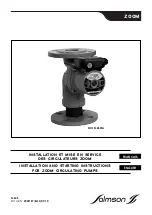
English (GB)
18
9.2 Electronic diaphragm leakage sensor
9.2.1 Technical data
Model 230 V (+ 10 %/- 10 %)
Model 115 V (+ 10 %/- 10 %)
• Contact load: 250 V / 6 A, max. 550 VA
• Power consumption: 1.15 VA
• Enclosure class: IP65
• Permissible temperature range: 0 °C to +40 °C.
9.2.2 Dimensional sketch (electronics enclosure)
Fig. 19
Electronics enclosure
9.2.3 Function
Pumps prepared for diaphragm leakage detection:
• Special dosing head flange for inserting the optoelectronic
sensor
• The optoelectronic sensor contains
– infrared sender
– infrared receiver.
In case of a leaking diaphragm
• The dosing liquid penetrates the dosing head flange.
– The light refraction will be changed.
• The sensor produces a signal.
– The electronics switches two contacts. These contacts can
for instance be used to trigger an alarm device or to switch
off the pump.
Fig. 20
Diaphragm leakage sensor
9.2.4 Electrical connection of the electronics
To ensure electromagnetic compatibility (EMC), the input cables
and current output cables must be screened.
1. Connect the screen at one end to PE.
– Refer to the connection diagram!
2. Route input cables, current output cables and power supply
cables in separate ducts.
3. Connect the device to the power supply according to the
connection diagram.
4. Connect the electronics with the sensor according to the
connection diagram.
5. Connect contacts 1 and 2 according to individual needs.
See section
9.2.5 Relay outputs
• Interference suppression is required for inductive loads (also
relays and contactors).
• If this is not possible, protect the relay contacts using a
suppressor circuit as described below.
With AC voltage
With DC voltage
• Connect the free-wheeling diode parallel to the relay or
contactor.
Fig. 21
Suppressor circuit DC/AC
T
M
03
63
81
45
06
T
M
03
63
82
45
06
Warning
Electrical connections must only be carried out
by qualified personnel!
Disconnect the power supply before connecting
the power supply cable and the relay contacts!
Observe the local safety regulations!
Protect the cable connections and plugs from
corrosion and moisture.
Caution
Before connecting the power supply cable,
check that the supply voltage stated on the pump
nameplate corresponds to the local electricity
supply. An incorrect power supply could destroy
the unit!
130
113.5
63
.5
80
Warning
The potential-loaded contact 1, terminals 6 and 7,
is loaded with supply voltage.
Switch off the power supply before connecting
contact 1!
Caution
The contacts have no protective circuits.
Only pure ohmic loads may be switched.
For switching the pump motor, a contactor has to
be connected inbetween.
Note
The relay output connection depends on the
application and the connected actuators.
Current up to
Capacitor C
Resistor R
60 mA
10
μ
F, 275 V
390
Ω
, 2 W
70 mA
47
μ
F, 275 V
22
Ω
, 2 W
150 mA
100
μ
F, 275 V
47
Ω
, 2 W
1.0 A
220
μ
F, 275 V
47
Ω
, 2 W
TM
03
72
09
45
13
Caution
Provide relay outputs on site with an appropriate
back-up fuse!
Note
These connections depend on the type of
actuator used and should only be understood as
guidelines. Refer to actuator documentation.
AC
DC +
-
R
C















































